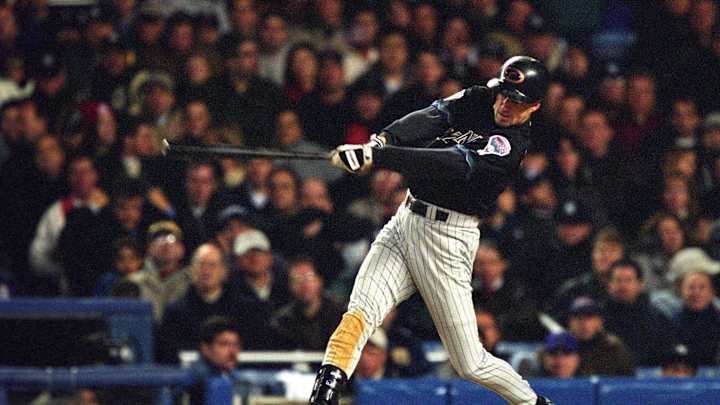Top 3 Centerfielders in Diamondbacks History

The Diamondbacks have been blessed with excellent centerfield play over the franchise's history. Today we take a look at the top three centerfielders to take the field for Arizona. For the full statistics table, check out this baseball-reference link
Steve Finley LHB: 849 G, .278/.351/.500, 111 OPS+, 18 WAR, +22 Fldg Runs
Steve Finley was drafted by the Baltimore Orioles in 1987. He became a star centerfielder after a trade to the Houston Astros in 1991, relying on speed, defense, and extra base hits to generate value. Through his first eight seasons he hit just 47 homers however. That changed in 1996 when he hit 30 homers for the San Diego Padres. Signed by the Diamondbacks as a 34 year old free agent prior to the 1999 season, Finley continued to excel at a high level hitting for power and providing excellent defense.
That first season in Arizona he mashed 34 homers driving in 103 runs and scoring 100, while posting +17 defensive runs saved, winning the NL Gold Glove for the third time in his career. He followed that up with a 35 homer season and 96 RBI, 100 runs scored and another Gold Glove in 2000. 2001 was a down year for Finley statistically but he had a tremendous postseason, helping key the team's run to their first and only World Championship. In 17 postseason games Finley led the team in batting, producing a slash line of .365/.441/.462, .902 OPS, and scoring 8 runs while driving in 7.
Finley went on to post three more 20 homer seasons while playing nearly every game. For his Diamondback career Finley was an iron man, playing 849 out of a possible 915 games, or 92%. He was traded to the Dodgers at the 2004 trade deadline finishing his six year D-backs career with 153 homers and 70 stolen bases. Finley is a member of MLB's 300 Homer, 300 stolen base club, of which there are just eight members.
A.J. Pollock, RHP, 637 G, .281/.338/.467, 113 OPS+, 19 WAR, +39 Fldg Runs
The Diamondbacks selected A.J. Pollock from the University of Notre Dame with the 17th overall pick in the first round of the 2009 draft. Pollock missed all of the 2010 season due to an elbow injury that required surgery. He bounced back to hit over .300 the next two minor league seasons earning a call up in 2012. After a solid but unspectacular 3.1 WAR season in 2013, Pollock had a breakout year in 2014. Through the end of May he was hitting .316 with a .920 OPS and had 26 extra base hits. Unfortunately he suffered a broken hand due to a hit by pitch, missing the next three months, not returning until September 2nd. He finished the year over .300 with a 134 OPS+ however.
Pollock resumed his breakout in 2015, posting arguably the best ever season by a D-back centerfielder. In 157 games he posted 7-WAR, batted .315 with 65 extra base hits, including 39 doubles, 6 triples and 20 homers. He stole 39 bases while getting caught just seven times, and won the Gold Glove in center field with +10 defensive runs saved. Pollock made the All Star team that year and seemed well on his way to a strong career.
Unfortunately he re-injured his elbow in spring of 2016 and missed all but 12 games that year. Pollock missed time with various injuries in 2017 and 2018 as well, playing in just 112 and 113 games respectively. He posted good, well above average numbers when he did play, but not quite to the level of 2015. Pollock is arguably pound for pound the best centerfielder in franchise history, at least on a rate basis. Compared to Finley he actually posted slightly higher WAR, Wins Above Average, OPS+, and Win Percentage added in 212 fewer games played. But he played in just 66% of possible games during his D-backs career. Perhaps the most important ability is availability.
Chris Young RHB: 885 G, .239/.318/.437, 95 OPS+, 14 WAR, +34 Fldg Runs
Chris Young was acquired by then GM Josh Byrnes in December of 2005 from the White Sox in a trade that sent Javier Vasquez to Chicago. After a very good season for Triple-A Tucson, Young made his major league debut in 2006, getting into 24 games in September. By mid season of his rookie year he was the every day leadoff hitter, and ended up smashing 32 homers and stealing 27 bases, and finished 4th in the Rookie of the year voting. A highlight from that season was Young's homer against Ted Lilly in the NLDS, prompting this reaction.
Young went on to post good power and fielding numbers for the majority of his D-backs career, and had back to back 5-WAR seasons in 2010-11. He was off to a great start in 2012 too, but a shoulder injury suffered running into the wall ruined the remainder of that year and he was traded as soon as the season was over. Young hit 132 homers and stole 112 bases to go with his +34 fielding runs as a Diamondback. The knock on Young was he was both strikeout and pop out prone, thus limiting his batting average and on base percentage, and reducing the opportunities to use his speed. Those issues aside, he easily slots into the third position on this list.
